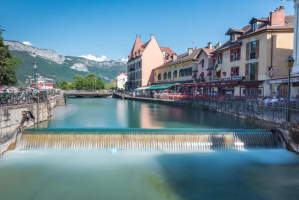Discovering Five Hidden Gems in Germany

In Germany, there are several places that are extremely popular with tourists due to their historical and cultural significance, as well as their art museums, opera houses, shopping districts, and so forth. Berlin, Munich, Frankfurt are all places that are extremely popular with tourists because of their historical and cultural significance. There is much more to Germany than just its big cities. Here are five worth exploring hidden gems that you might not see on a typical vacation to Germany.
Kiel, Germany
A city on the northern coast of Germany, Kiel lies along the Baltic Sea, not too far away from Denmark. It is one of the most important maritime centers in Germany. As a result of its location, it has been a maritime center for Germany for many years. In fact the sailing competitions at both the 1936 and 1972 Olympic Games took place there. “Kiel Week,” the largest sailing festival of the year held in June. It attracts over 5,000 sailors and 2,000 sailing ships every year. For those who are more interested in the land than the sea, Kiel is home to two renowned botanic gardens. Both dated from the mid-17th century, Neuer Botanischer Garten and Alter Botanischer Garten are open to the public every day.
Lubeck, Germany
It is Germany’s largest Baltic Sea port, located in the same region as Kiel. In the eighth century, various Slavic tribes settled Lubeck. An imposing castle and town were built in the twelfth century by the Count of Holstein and Schauenburg, Adolf II. Over the years, Lubeck traded hands between the Danes and the Germans, but by the fourteenth century, the Holy Roman Emperor Charles IV named Lubeck as one of its five glory cities. During the Napoleonic Wars, France temporarily occupied Lubeck, and the once prosperous city fell into relative obscurity. Although Lubeck has not regained its glory as the “Glory of the Empire,” it remains an impressive city to visit for history buffs. As a result of war and bombing, much of Lubeck’s original medieval city center remains or has been restored. It was proclaimed a World Heritage Site by UNESCO in 1987.
Bremen, Germany
Also in the north of Germany, but on its western side, is the city of Bremen. Bremen is the second most populous city in northern Germany. This is a large city but it lacks the hustle and bustle of larger cities such as Berlin and Frankfurt. In the past, Bremen has been a popular destination for tourists from the USA and western Europe because of its German beers Beck and St. Pauli Girl. During World War II, it was heavily damaged by Allied bombing. Despite the severe damage it suffered, Bremen was able to quickly recover. Today it is almost completely restored to its former glory.
Munster, Germany
A small city in the northwest of Germany, south of Bremen, is the city of Munster. With a population of just under 300,000 people, Munster is large enough to be considered a “major city”, but still small enough to be considered relaxed. Although Munster is less well known as a tourist destination than Bremen, it has a rich history and a lot of historical sites to explore. In fact, Munster is a very popular tourist destination amongst German and Dutch tourists. But very few visitors come to the city outside of Germany. As is the case with many old German cities, Munster’s city center is a mixture of medieval and modern architecture; outside the city, the surrounding countryside is also a place worth visiting.
Erfurt, Germany
The city of Erfurt is the capital of the Thuringia region in central Germany. Erfurt also has a beautiful medieval city center, but unlike the other cities mentioned above, the city center was not rebuilt after World War II - Erfurt sustained only minimal damage during the war. As a result, Erfurt has the most attractive city center in all of Germany, and has so many churches that it is nicknamed “the Rome of Thuringia.” Luther received his university education and entered the priesthood in Erfurt, not the Vatican. For Lutherans, visiting Erfurt is a true pilgrimage; for other tourists, it is a quiet, quaint city that boasts many interesting sights.







